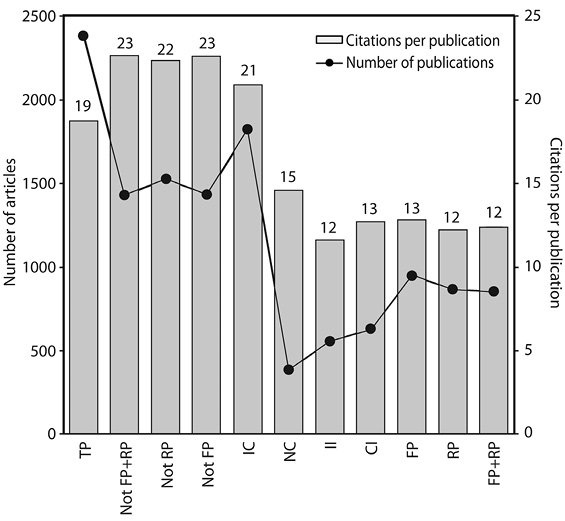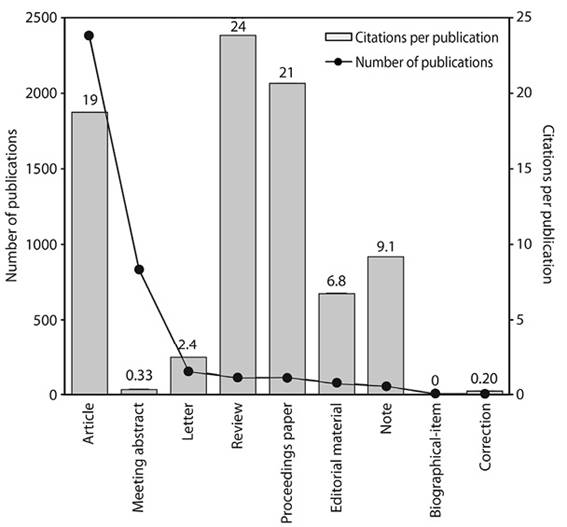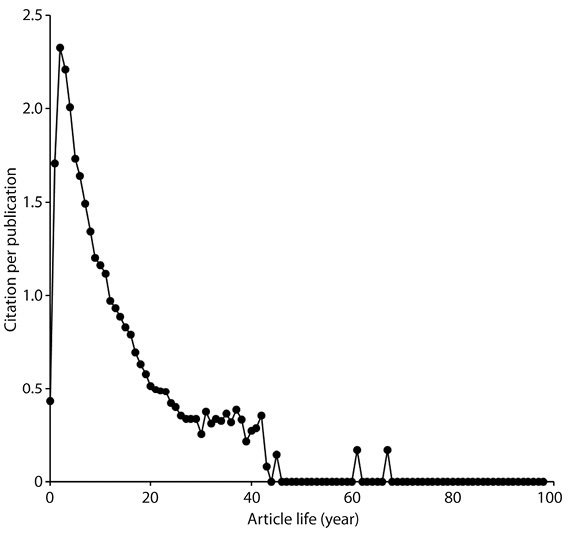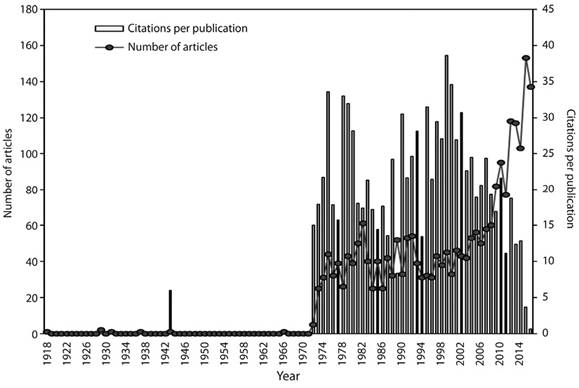Guatemala, with 16 million inhabitants, is the largest economy of Central America and should have the largest scientific output of the region. However, this is not the case: with a per capita Gross Domestic Product of $ 4 000, Guatemala is below its neighbors Mexico ($ 18 000) and Honduras ($ 4 700). A series of dictatorships that started in 1871, and a genocidal civil war from 1960 to 1996, prevented the country from developing a proper scientific establishment and even from properly feeding its people (Marini & Gragnolati, 2003). For this reason, Guatemala does not occupy the expected place in the ranking of science in the Central American context.
Previous studies in this series have analyzed the scientific output of other Central American countries. One of the smallest countries in the isthmus, Costa Rica, leads the region with nearly 7 000 publications in the database, about half of them produced in international collaboration and dominated by biology and medicine (Monge-Nájera & Ho, 2012). The second most productive Central American country is Panama, also a small country, with over 4 800 publications that show strong collaboration with the USA and concentration on forest ecology (Monge-Nájera & Ho, 2015). The third and fourth places are occupied by the largest countries, Honduras and Nicaragua. Honduras, with 1146 publications mostly about health and agriculture, is the Central American country with less scientific journals (Monge-Nájera & Ho, 2017b). Nicaragua has over 800 publications in the database, dominated by medical research in which Nicaraguan scientists play a secondary role within international teams (Monge-Nájera & Ho, 2017a). El Salvador, second smallest country in the region, is also among the less productive, with 788 publications mostly from the social sciences (Monge-Nájera & Ho, 2017c).
Even though there are no in-depth studies about the scientific output of Guatemala, it has been included in a series of larger studies from 1982 through 2015. In the transition from the decade of 1970 to that of 1980, Guatemala was increasing the number of articles included in the Science Citation Index (SCI) database (Blickenstaff & Moravcsik, 1982), but still that meant a low number of only 18 articles (Garfield, 1983). They had 96 citations in journals covered in the index, which led Garfield (1983) to place it in the world’s middle impact category, despite the fact that in the SCI countries with very low numbers produce misleading results (for example, one country with 1 article and 5 citations is considered as successful as one with 1 000 articles and 5 000 citations, albeit clearly their real impact in world science is quite different).
In the decade of 1980, around 40 Guatemalan articles per year were included in the SCI and Guatemala occupied the 83rd. place in the list (Braun, Glanzel & Schubert, 1988; Lewison, Fawcett-Jones & Kessler, 1993), accumulating to 1993 nearly 600 articles, better than its similarly sized neighbor Honduras, which only had 108 articles (Garfield, 1995; Fernández, Gómez & Sebastian, 1998).
Considering the economically active population, Guatemala was just under the Latin American average in productivity (DeMoya-Anegón & Herrero-Solana, 1999), but this result, based on all scientific fields, did not include computing science, where Guatemala only had one article in the year 2007, just like Honduras, and far below Mexico, which had 5 000 (Rojas-Sola & Jordá-Albiñana, 2009). Finally, the most recent study reported that Guatemala only has three Open Access scientific journals (Alonso & González, 2015).
Materials and methods
We used the Science Citation Index Expanded (SCI-EXPANDED), Web of Science Core Collection, Thomson Reuters. We searched for the word “Guatemala” in the address field and found 3 697 documents, published between 1900 and 2016 (Date of search: June 19th, 2017). Results were refined by countries/territories with Guatemala. We discarded 63 documents with “Guatemala” in the address field that were not actually from the country (for example USDA, Aphis, Guatemala Medfly Methods Stn, Usemb Aphis Unit 3319, Apo, AA 34024; Rua Guatemala, 190 Alto Rio Preto, BR-15020260 Sao Jose Do Rio Preto, SP, Brazil; and Ctr Dis Control, Ctr Infect Dis, Div Parasit Dis, Med Entomol Res Unit Guatemala, Atlanta, GA 30333). In total, 3634 documents were finally found as publications by authors from Guatemala (including several types of document). Only 2380 that were formal articles were further analysed.
For international collaborative documents, we reclassified articles from England, Scotland, Northern Ireland, and Wales as “United Kingdom” (UK). Articles from the Union of Soviet Socialist Republics (USSR) were checked and reclassified as being from Russia (Ho et al., 2016).
To investigate citations, five indicators C year, TC year, C 0, TCPY, and CPP 2016 were applied. The “impact of an article in recent year” is considered as the number of citation from Web of Science Core Collection of an article in the recent year only, C year (Ho, 2012), for example 2016, is referred to as C 2016, and citations of articles are considered as the total number of citations since publication to the end of the recent year was referred to as TC year (Wang et al., 2011; Chuang et al., 2011). C 0, the total number of citations of an article in its publication year (Ho and Kahn, 2014). TCPY, the citations per year (TC year/year) (Ho, 2012). CPP 2016, citations per publication (CPP 2016 = TC 2016/TP) (Ho, 2012; Elango & Ho, 2017).
Affiliations in Federal Republic of Germany (Fed Rep Ger) and German Democratic Republic (Ger Dem Rep) were reclassified as being from Germany (Ho, 2014). Affiliations in Zaire were checked and reclassified as from the Democratic Republic of the Congo (Dem Rep Congo) (Pouris & Ho, 2014). Affiliations in Yugoslavia were checked and reclassified as being from Slovenia (Ho, 2014). Affiliations in the Union of Soviet Socialist Republics (USSR) were checked and reclassified as being from Russia (Ho, 2012). Similarly, Acad Sci USSR were checked and reclassified as being from the Russian Acad Sci (Chuang & Ho, 2014).
Tables appear in Digital Appendix 1 and additional figures in Digital Appendix 2. References for the main text appear in the printed version, while references to literature cited only on tables and figures are included in their own digital appendix as “Additional References”.
Results
Articles greatly dominate the Guatemalan presence in the SCIE, followed by meeting abstracts; all other publication types are minor in number (Figure 1). The most cited types of publication in this database are reviews, with a mean of 24 citations, followed by proceedings (21 citations) and articles (19 citations); letters and meeting abstracts are seldom cited (Figure 1, table 1).
Correction notes have the highest number of authors, with a mean of ten authors per publication, followed by articles (7.4 authors), and meeting abstracts (6 authors; table 1).
The majority of articles in this database are in English, followed by Spanish (10 %) and minimal numbers in French, Portuguese and German (table 2). In comparison with those in Spanish, articles in English had twice the number of coauthors and received seven times more citations (table 2).
Publications received most citations in the third year, and then citation falls gradually for three decades, reach a plateau in the fourth decade and articles basically stop being cited after 40 years (Figure 2).
The SCIE records few citations for Guatemalan publications before 1970, when the literature mostly was not available in digital form, and afterwards peaked in output in the mid 1970s and again around the year 2000; in the same period citation has increased constantly since the 1990s (Figure 3).
Both productivity and citation are higher for international publications than for strictly Guatemalan works (Figure 4).

Figure 4 Productivity and citation according to nationality in local and internationally produced articles. TP: total articles. Not FP+RP: both first and corresponding authors are not from Guatemala. Not RP: corresponding author is not from Guatemala. Not FP: first author is not from Guatemala. IC: internationally collaborative papers. NC: nationally collaborative papers. II: institutional independent papers. SI: Guatemala independent papers. FP: first author is from Guatemala. RP: corresponding author is from Guatemala. FP+RP: both first and corresponding authors are from Guatemala.
According to Web of Science categories, the highest percentage of publication are in the fields of Nutrition and dietetics; Public, environmental and occupational health; and Tropical medicine (fig. 5), while distribution of publications by number of journals is dominated by Pharmacology, Plant Sciences and Public, environmental and occupational health (Fig. 5). Agriculture and nature receive little research attention (table 3).
A larger number of publications appeared in journals from the nutrition and health categories, namely Archivos Latinoamericanos de Nutrición, American Journal of Clinical Nutrition and American Journal of Tropical Medicine and Hygiene; however there is no strong dominance, the journal with most articles (Archivos) only had 6.7 % (table 4).
Collaboration with foreign institutions is on the rise in Guatemalan science, and the leading collaborators are institutions from the USA, Mexico and the United Kingdom (fig. 6). The USA clearly dominated, with 49 % of papers, while most countries had 5 % or less (Table 5).
When only the geographically closest countries are analyzed, the rapid increase in collaboration stands out and the leading countries are in Central and South America (fig. 7). Mexico co-produced 12 %, Costa Rica 5 % and Colombia 4 % (table 5).
For the top cited articles, the historical citation pattern differs, some stay relatively constant before a final slow decline, some have clear peaks (figure 8).
Lifespan for top cited articles ranges from less than 2 to 14 years, but mostly is around 4 or 5 years (fig. 9).
For the top cited articles in 2016, a value that has been established by Ho (2012) to allow for meaningful meta-analyses, the historical citation is a growing curve (fig. 10) that also appears for top cited articles by total citation (fig. 11) and for articles in both the top ten TC 2016 and C 2016 (fig. 12).
Top producing Guatemalan institutions have three basic historical patterns: steady production (Center for Studies of Sensory Impairment, CESSIAM); rapid growth (Universities of San Carlos and del Valle), and strong reduction (Central American Nutrition Institute, INCAP; figure 13). Even though it now has only a limited presence, in its early years the INCAP was a powerful institution that accumulated 21 % of all Guatemalan production in the SCIE. The public universities and the sensory impairment center CESSIAM produced the other important proportions of publications (table 6).
The top five researchers signing from Guatemalan institutions were N.W. Solomons, R. Bressani, L.G. Elias, C. Rolz and A. Cáceres (table 7). Noel Solomons is the founder of the CESSIAM and an expert in the relationship between food and health; R. Bressani was the editor of the journal Archivos Latinoamericanos de Nutrición and a nutrition expert at INCAP; Luis G. Elías was also a nutrition expert at INCAP; C. Rolz is a chemical engineer at the Universidad del Valle who has worked in reducing the environmental impact of coffee and cane production; and A. Cáceres (Universidad de San Carlos) is an expert in the identification of medical compounds from Guatemalan plants.
When Web of Science categories are analyzed, the citation pattern oscillated widely with time, with no clear overall trend to increase or decrease (fig. 14).
The overall top cited articles show a clear concentration in health, particularly nutrition (table 8). The top cited articles deal with an international study of the human papillomavirus; and treatments for asthma, adenocarcinoma, diarrhea, pneumonia, influenza, psoriasis and hypertension (table 8).
For publications in which all authors are from Guatemalan institutions, the top cited articles are about nutrition in children, clinical efficacy of ciprofloxacin and the anti-gonorrhoeal activity of Guatemalan plants (table 9).
Discussion
The domination of articles over other types of publication is typical of Latin American countries, and Guatemala is not an exception. The reason for this seems to be the fact that only articles qualify for salary improvement in Latin American universities (Sábato & Botana, 1993). The nearly universal use of English in the articles from Guatemala in the SCI-expanded does not reflect a characteristic of Guatemalan science, which produces many articles in Spanish, but reflects the fact that the SCI-expanded is biased against journals that are not in English and that are published outside the USA and Western Europe (Monge-Nájera, 2014). In fact, none of the 18 Guatemalan scientific journals are included in the SCI-expanded (http://ip-science.thomsonreuters.com/cgi-bin/jrnlst/jloptions.cgi?PC=K).
The fact that the SCI-expanded stops counting citations after the second year (Garfield, 2006) greatly affects Latin American science because most citations there take place after the second year (Monge-Nájera & Ho, 2012; 2015; 2017a-c). For those articles that are covered in the database, the patterns are also similar to those previously reported for other Central American countries, i.e. articles in English are more cited because they have a larger readership, reviews are more cited because they summarize knowledge, and international projects are more cited because they are better funded and are of more general interest, usually in the field of health research (Monge-Nájera & Ho, 2017a-c).
The institutions with growing productivity in the database are universities with contrasting characteristics: the University of San Carlos, among the oldest in the continent (founded in 1676), is a public institution of 200 000 students, while Del Valle Universiy is a small private institution (10 000 students) founded in 1966, but both are overcoming the disdain for publication typical of Guatemalan universities, thanks in part to the arrival of a new generation of researchers trained in Europe and the USA (Martínez-Folgar & Salomon, 2017).
The CESSIAM, a NGO with a steady production about the relationship of food and health founded in 1985, has always had research as key objective and has been under the same leadership for decades, which can explain why its output has remained good and stable over the years (http://www.inffoundation.org/research/cessiam.htm). Finally, the fall in productivity of the Central American Nutrition Institute, INCAP (www.incap.int), financed by the PAHO and private foundations, might reflect a change in leadership (M. Campos, pers. commun.).
The top authors from Guatemala match the list of top institutions, suggesting that they are the motivating leaders of productivity in their institutions. However, since they seem to have no peers of the same level in their institutions, those institutions may lose a significant part of their output if those particular scientists stop working for them, another known problem of science in Latin America (Nájera, Nielsen-Muñoz, & Azofeifa, 2010). A positive finding is, that contrary to other Central American countries (Monge-Nájera & Ho, 2017, a-c), Guatemalan authors are in some cases the leaders in the research teams signing high impact articles in the Science Citation Index.
Serious economic inequality, and a lack of interest in scientific research, keep Guatemala low in the Central American ranking of scientific productivity (Martínez-Folgar & Salomon, 2017); only Honduras has less articles in the database (Monge-Nájera & Ho, 2017b), but the growing trend in productivity and citation in the SCI-expanded is ground for optimism. The productivity and citation of Guatemalan science in the 18 journals published in the country, and in other journals also not covered in the SCI-expanded, remain unknown and must be borne in mind as a limitation of the present study, which did not include all of the scientific output of the country but only those documents that are included in the SCI-expanded. Previous work has shown that, for Latin American countries, the number of citations not included in the SCI-expanded may greatly outnumber citations in that database (Monge-Nájera, 2014).
In conclusion, Guatemala represents a particular case in Central America because its high quality research is highly dependent on particular researchers rather than on institutions, and because the total output is well under the expectation. Nevertheless, the historical trend is positive, with a clear growth of international collaboration, productivity and citation.












 uBio
uBio 




